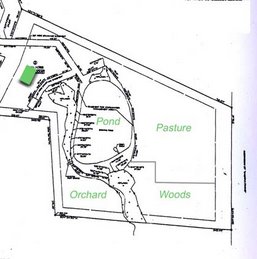Last spring we lost several ducks to foxes, but so far this year we have been fortunate and haven't lost a one. Nonetheless, we have a daily roll call. The current "beak count" is eight: 2 pekins, 3 khaki campbells, and 3 cayugas. We may soon be down a cayuga if one keeps up the bizarre behavior demonstrated this week.
The cayugas and one of the khakis have taken to long walks, up our driveway and yes, even up to the end of our street. They've done this before when we've neglected to feed them, but that's not the case this time. They just like sitting in the grass near a house that's under construction. Maybe they're just into the builders. However, this past week Chris was out working in the pasture and could hear a faint quacking kind of sound coming from the housing development that's behind the pasture. He assumed it was the family of geese that have been hanging around our pond, because they travel back and forth between our place and another nearby pond.
 Then towards evening Chris heard the same sound, this time out in front of the house. He looked out and watched a cayuga proudly strutting from the main road, down our street, and then down the driveway. The rest of the flock rushed to welcome the prodigal, and there was much quacking all around.
Then towards evening Chris heard the same sound, this time out in front of the house. He looked out and watched a cayuga proudly strutting from the main road, down our street, and then down the driveway. The rest of the flock rushed to welcome the prodigal, and there was much quacking all around.So it appears this crazy duck found her way to the other housing development, possibly by way of our pasture. But then it also appears she returned home via the main road, a 1/2-mile walk with traffic! A day later she disappeared for a full 24 hours, and returned by the same route. 

Is someone feeding her? Does she have a secret lover? Or is she just insane? Cayugas, after all, are the same breed as Daffy Duck. We're keeping our eye on her ...



.jpg)




